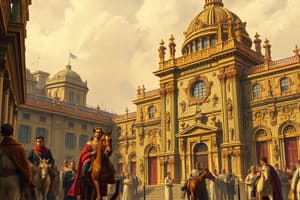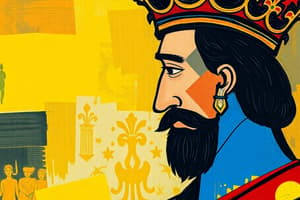Podcast
Questions and Answers
What was one major consequence of the nobles in Spain not paying taxes?
What was one major consequence of the nobles in Spain not paying taxes?
- The economy flourished due to increased investments.
- Wealth accumulation was hindered among the lower classes. (correct)
- Taxation was redistributed evenly among all classes.
- The middle class rapidly developed.
Which of the following statements about Spanish manufacturing during the Middle Ages is correct?
Which of the following statements about Spanish manufacturing during the Middle Ages is correct?
- Spanish guilds adopted innovative business practices.
- Spanish manufactured goods were more expensive than those made elsewhere. (correct)
- The Spanish economy was completely independent of foreign markets.
- Spanish goods were produced using modern techniques.
What was a significant economic challenge faced by Spain during Philip's reign?
What was a significant economic challenge faced by Spain during Philip's reign?
- Frequent declarations of bankruptcy by the Spanish state. (correct)
- Excess wealth accumulation among the nobility.
- Successful infrastructure projects benefiting the lower classes.
- Dependence on local industries for economic growth.
What led to the Dutch Revolt against Spanish rule?
What led to the Dutch Revolt against Spanish rule?
What was one of Philip's actions in the Netherlands that escalated tensions?
What was one of Philip's actions in the Netherlands that escalated tensions?
What was the outcome of the Spanish attempts to suppress the Dutch revolt?
What was the outcome of the Spanish attempts to suppress the Dutch revolt?
Which of the following groups primarily benefited from Spain’s wealth during this period?
Which of the following groups primarily benefited from Spain’s wealth during this period?
How did the sluggish economy of Spain compare with that of the Netherlands during Philip's rule?
How did the sluggish economy of Spain compare with that of the Netherlands during Philip's rule?
What was one of the primary reasons for Philip’s military campaigns against the Ottomans and Protestants?
What was one of the primary reasons for Philip’s military campaigns against the Ottomans and Protestants?
What was the aim of the Spanish Armada launched by Philip in 1588?
What was the aim of the Spanish Armada launched by Philip in 1588?
Which architectural feature of Philip’s palace, the Escorial, symbolized his power?
Which architectural feature of Philip’s palace, the Escorial, symbolized his power?
What significant cultural period did Spain experience during the 16th and 17th centuries?
What significant cultural period did Spain experience during the 16th and 17th centuries?
Which two painters are noted for their contributions during Spain’s golden age?
Which two painters are noted for their contributions during Spain’s golden age?
What impact did the defeat of the Spanish Armada have on Spain?
What impact did the defeat of the Spanish Armada have on Spain?
Which historical family used the Inquisition to investigate suspected heretics in Spain?
Which historical family used the Inquisition to investigate suspected heretics in Spain?
What was the primary objective of the defensive strategy implemented by the League of Augsburg?
What was the primary objective of the defensive strategy implemented by the League of Augsburg?
Which countries were part of the League of Augsburg?
Which countries were part of the League of Augsburg?
What event triggered the War of the Spanish Succession?
What event triggered the War of the Spanish Succession?
Which significant territorial gain did Great Britain achieve as a result of the Treaty of Utrecht?
Which significant territorial gain did Great Britain achieve as a result of the Treaty of Utrecht?
What impact did Louis XIV's wars have on the French population during this period?
What impact did Louis XIV's wars have on the French population during this period?
What was the outcome of the Treaty of Utrecht regarding the thrones of France and Spain?
What was the outcome of the Treaty of Utrecht regarding the thrones of France and Spain?
Which of the following was a contributing factor to the weakening of France during Louis XIV's reign?
Which of the following was a contributing factor to the weakening of France during Louis XIV's reign?
Who was the leader of the forces opposing the Bourbon dynasty's expansion in Europe?
Who was the leader of the forces opposing the Bourbon dynasty's expansion in Europe?
What was a significant consequence of the crises faced by monarchs in the 17th century Europe?
What was a significant consequence of the crises faced by monarchs in the 17th century Europe?
What does absolutism in governance primarily involve?
What does absolutism in governance primarily involve?
Which monarch is mentioned as a prominent example of absolutism in the 17th century?
Which monarch is mentioned as a prominent example of absolutism in the 17th century?
What motivated monarchs to increase their power during the 17th century?
What motivated monarchs to increase their power during the 17th century?
How did the approach of rulers differ when consulting their subjects versus their peers?
How did the approach of rulers differ when consulting their subjects versus their peers?
What primary factor contributed to unrest among the populations in 17th century Europe?
What primary factor contributed to unrest among the populations in 17th century Europe?
What is one way that absolute rulers attempted to ensure order in their states?
What is one way that absolute rulers attempted to ensure order in their states?
What impact did the lack of a middle class have on the economy of Spain during this period?
What impact did the lack of a middle class have on the economy of Spain during this period?
What was one of the main reasons for the weakness of the Polish nobility's power structure?
What was one of the main reasons for the weakness of the Polish nobility's power structure?
Which major event severely impacted the Holy Roman Empire and reduced its authority over the German states?
Which major event severely impacted the Holy Roman Empire and reduced its authority over the German states?
What action did the Hapsburgs take to consolidate their power during the Thirty Years’ War?
What action did the Hapsburgs take to consolidate their power during the Thirty Years’ War?
Which empire's decline began after the peak of power marked by Suleyman the Magnificent?
Which empire's decline began after the peak of power marked by Suleyman the Magnificent?
What was one of the key strategies employed by the Hapsburgs to establish absolute rule?
What was one of the key strategies employed by the Hapsburgs to establish absolute rule?
After the Thirty Years’ War, what challenge faced the Hapsburg ruler Charles VI?
After the Thirty Years’ War, what challenge faced the Hapsburg ruler Charles VI?
What was the primary consequence of the vacuums left by weak empires in central Europe?
What was the primary consequence of the vacuums left by weak empires in central Europe?
What long-term impact did the Polish nobility's limitations on the king's power have on the state?
What long-term impact did the Polish nobility's limitations on the king's power have on the state?
What marked the beginning of the modern state system in Europe?
What marked the beginning of the modern state system in Europe?
Which of the following accurately describes a nation-state?
Which of the following accurately describes a nation-state?
Which major powers represented Central Europe during the mid-1600s?
Which major powers represented Central Europe during the mid-1600s?
How did the formation of states in Central Europe compare to Western Europe?
How did the formation of states in Central Europe compare to Western Europe?
What was a characteristic of the major European powers in the mid-1600s?
What was a characteristic of the major European powers in the mid-1600s?
What role did religion play in the motivations of states during this period?
What role did religion play in the motivations of states during this period?
Which of the following statements is true about Poland in the 1600s?
Which of the following statements is true about Poland in the 1600s?
What can be inferred about the status of the Ottoman Empire during the mid-1600s?
What can be inferred about the status of the Ottoman Empire during the mid-1600s?
What significant outcome resulted from the Thirty Years’ War?
What significant outcome resulted from the Thirty Years’ War?
What was the primary political structure of states after the Thirty Years’ War?
What was the primary political structure of states after the Thirty Years’ War?
Flashcards
Philip II's Religious Duty
Philip II's Religious Duty
Philip II believed it was his duty to protect Catholicism from threats like the Ottoman Empire (Muslims) and Protestants in Europe.
Philip's crusade against the Ottoman Empire
Philip's crusade against the Ottoman Empire
Philip II's goal was to fight the Ottoman Empire and protect Catholicism. He believed it was his duty to defend the faith.
Battle of Lepanto
Battle of Lepanto
The Battle of Lepanto was a major victory for the Catholic forces against the Ottoman Empire, led by a combined fleet of Spanish and Venetian ships. It was a key moment in the struggle against the Ottoman expansion.
Spanish Armada
Spanish Armada
Signup and view all the flashcards
Escorial
Escorial
Signup and view all the flashcards
Golden Age of Spanish Art and Literature
Golden Age of Spanish Art and Literature
Signup and view all the flashcards
El Greco
El Greco
Signup and view all the flashcards
Velázquez
Velázquez
Signup and view all the flashcards
Absolute Monarchy
Absolute Monarchy
Signup and view all the flashcards
17th Century Europe: A Time of Upheaval
17th Century Europe: A Time of Upheaval
Signup and view all the flashcards
Crises Lead to Absolutism
Crises Lead to Absolutism
Signup and view all the flashcards
Why Did Monarchies Become More Powerful in the 17th Century?
Why Did Monarchies Become More Powerful in the 17th Century?
Signup and view all the flashcards
Monarchs Sought to Free Themselves from Limitations
Monarchs Sought to Free Themselves from Limitations
Signup and view all the flashcards
Louis XIV: The Famous Absolute Monarch
Louis XIV: The Famous Absolute Monarch
Signup and view all the flashcards
Huge Armies
Huge Armies
Signup and view all the flashcards
Heavy Taxes
Heavy Taxes
Signup and view all the flashcards
Spain's Lack of a Middle Class
Spain's Lack of a Middle Class
Signup and view all the flashcards
Spanish Guilds and Economic Dependence
Spanish Guilds and Economic Dependence
Signup and view all the flashcards
Spanish Borrowing and Debt
Spanish Borrowing and Debt
Signup and view all the flashcards
Spain's Financial Dependence on Enemies
Spain's Financial Dependence on Enemies
Signup and view all the flashcards
The Dutch Revolt
The Dutch Revolt
Signup and view all the flashcards
Factors Contributing to the Dutch Revolt
Factors Contributing to the Dutch Revolt
Signup and view all the flashcards
Cultural and Religious Divide
Cultural and Religious Divide
Signup and view all the flashcards
Economic Disparities
Economic Disparities
Signup and view all the flashcards
Central European States in the 1600s
Central European States in the 1600s
Signup and view all the flashcards
Nation-State
Nation-State
Signup and view all the flashcards
Modern State System
Modern State System
Signup and view all the flashcards
Sovereignty
Sovereignty
Signup and view all the flashcards
Balance of Power
Balance of Power
Signup and view all the flashcards
League of Augsburg
League of Augsburg
Signup and view all the flashcards
William of Orange
William of Orange
Signup and view all the flashcards
War of the Spanish Succession
War of the Spanish Succession
Signup and view all the flashcards
Treaty of Utrecht
Treaty of Utrecht
Signup and view all the flashcards
Gibraltar
Gibraltar
Signup and view all the flashcards
Bourbon Dynasty
Bourbon Dynasty
Signup and view all the flashcards
Louis XIV's Wars
Louis XIV's Wars
Signup and view all the flashcards
Weak Kings in Central Europe
Weak Kings in Central Europe
Signup and view all the flashcards
Ottoman Empire's Decline
Ottoman Empire's Decline
Signup and view all the flashcards
Holy Roman Empire's Weakness
Holy Roman Empire's Weakness
Signup and view all the flashcards
Hapsburgs' Rise to Power
Hapsburgs' Rise to Power
Signup and view all the flashcards
Hapsburgs' Reconquest of Bohemia
Hapsburgs' Reconquest of Bohemia
Signup and view all the flashcards
Hapsburgs' Centralization of Power
Hapsburgs' Centralization of Power
Signup and view all the flashcards
Hapsburgs' Retaking of Hungary
Hapsburgs' Retaking of Hungary
Signup and view all the flashcards
Charles VI's Challenges
Charles VI's Challenges
Signup and view all the flashcards
Study Notes
Absolute Monarchs in Europe
- Absolute monarchs, like Louis XIV of France, sought to control their countries' economies, aiming to reduce limitations imposed by the nobility.
- Louis XIV's palace at Versailles exemplified his power and wealth, demonstrating his absolute authority.
- The construction of Versailles cost a significant sum, indicating the extensive resources under the monarch's control.
- The painting depicting Louis XIV showcases his royal attire, highlighting the luxuriousness and lavishness of the fashion during that time period.
- Absolute rulers controlled many aspects of their countries, including the economy, religion, and social gatherings.
- Absolute monarchs in Europe ruled from the 16th to 18th centuries.
- The Peace of Augsburg, initially aimed at settling religious disputes, ultimately failed in solving the conflicts.
- The Thirty Years' War followed, a religious and territorial conflict greatly impacting Europe and its populations.
- The war drastically affected German population numbers (from 20 million to 16 million) and had long-term impacts on trade and agriculture, contributing to economic ruin.
- Multiple European powers (France, Austria, Spain and Prussia) experienced conflicts during the Thirty Years' War, which lasted from 1618 to 1648, significantly impacting the balance of power in Europe, especially the Hapsburg kingdoms.
The Reign of Louis XIV
- Louis XIV, a prominent absolute monarch, aimed to strengthen the French monarchy through various policies, notably weakening the nobility and increasing the power of the central government.
- Louis XIV's France became a powerful force in Europe during his reign.
- The Edict of Nantes, initially intended to provide religious freedom to Huguenots, was revoked, highlighting the extent of royal power.
- Louis's policies, while initially boosting France, also imposed heavy taxes that later fueled unrest.
- Religious wars, primarily between Catholics and Huguenots, shaped the political and social climate of France.
- Significant economic growth fueled cultural brilliance under Louis XIV's reign, involving financial policies and a prominent minister, Colbert.
Central European Monarchs Clash
- The Thirty Years' War (1618-1648) was a major European conflict marked by religious and political tensions.
- The war led to significant casualties and economic hardship in Central Europe, but ultimately ended with the Peace of Westphalia.
- The Peace of Westphalia (1648) ended the Thirty Years' War.
- This treaty, considered one of the most important treaties in European history, significantly shaped the political landscape of Europe, ultimately emphasizing the independence of various states.
- The treaty established a system of international relations where state sovereignty and religious tolerance became crucial aspects governing European relationships.
The War of the Spanish Succession
- Conflicts between European powers often arose from disputes involving crowns and territories during this period.
- Political tensions concerning the succession of the Spanish crown triggered a major war known as the War of the Spanish Succession (1701-1714).
- The war involved numerous European states vying for power and influence amidst dynastic disputes.
- European powers fought a war known as the War of Spanish Succession over the succession of the Spanish throne in 1700.
Absolutism in Europe
- Absolutism, a form of government where absolute power is held by one ruler, emerged in Europe, particularly in France during this period.
- Divine right, the notion that rulers derive legitimacy from God, strengthened the justification of absolute power.
- Absolute rulers used economic policies like mercantilism and increased taxation to fund their ambitions.
- Factors such as religious intolerance, economic instability, and conflicts led to the rise of absolutism in different parts of Europe.
- Various factors led to the eventual decline of absolutism in Europe.
Studying That Suits You
Use AI to generate personalized quizzes and flashcards to suit your learning preferences.
Related Documents
Description
Test your knowledge on key events and consequences of Spanish history during the reign of Philip II. This quiz covers topics such as economic challenges, the Dutch Revolt, and the significance of Spanish military actions. Discover crucial aspects of this transformative period in Spain's past.





